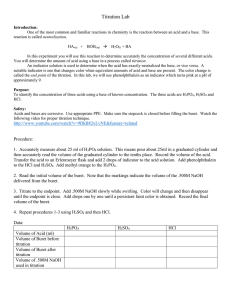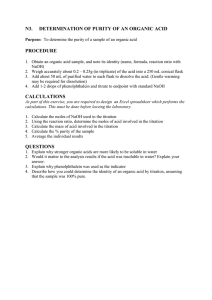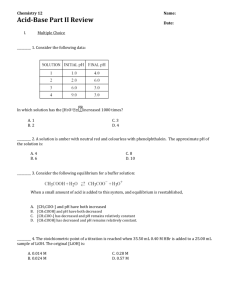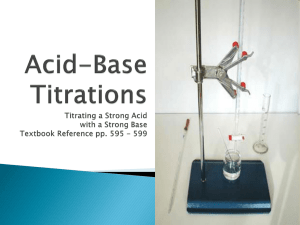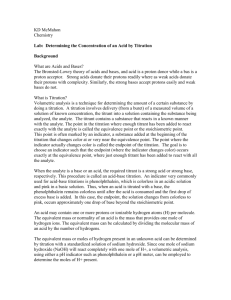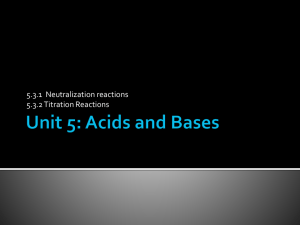Lab - Titration - Teacher
advertisement
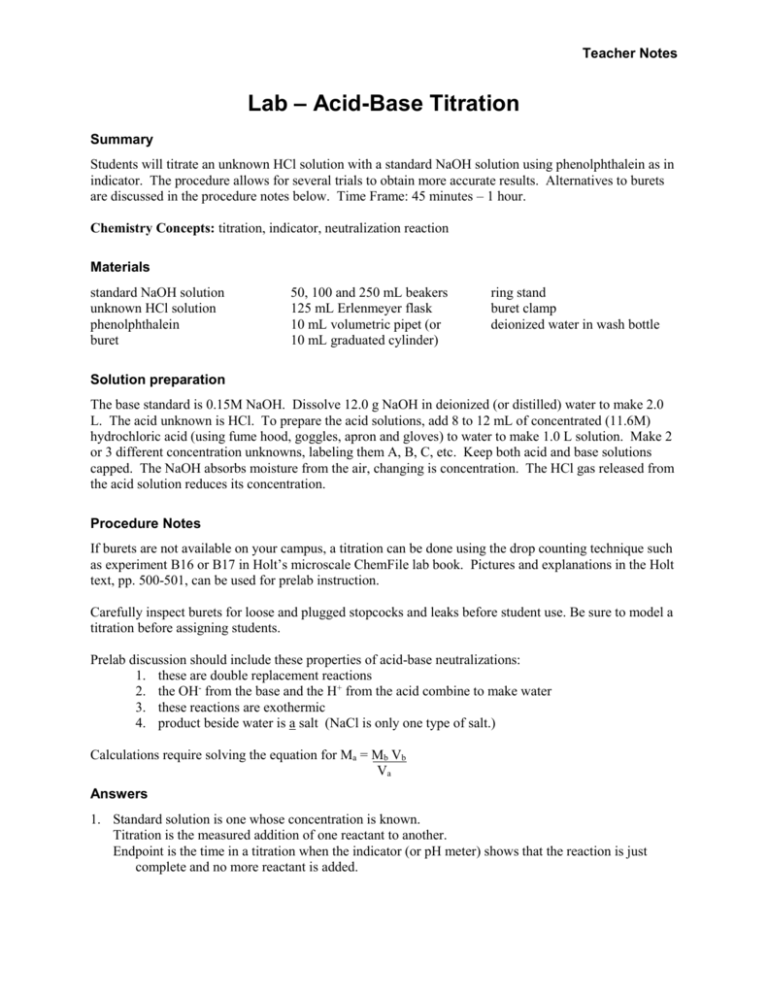
Teacher Notes Lab – Acid-Base Titration Summary Students will titrate an unknown HCl solution with a standard NaOH solution using phenolphthalein as in indicator. The procedure allows for several trials to obtain more accurate results. Alternatives to burets are discussed in the procedure notes below. Time Frame: 45 minutes – 1 hour. Chemistry Concepts: titration, indicator, neutralization reaction Materials standard NaOH solution unknown HCl solution phenolphthalein buret 50, 100 and 250 mL beakers 125 mL Erlenmeyer flask 10 mL volumetric pipet (or 10 mL graduated cylinder) ring stand buret clamp deionized water in wash bottle Solution preparation The base standard is 0.15M NaOH. Dissolve 12.0 g NaOH in deionized (or distilled) water to make 2.0 L. The acid unknown is HCl. To prepare the acid solutions, add 8 to 12 mL of concentrated (11.6M) hydrochloric acid (using fume hood, goggles, apron and gloves) to water to make 1.0 L solution. Make 2 or 3 different concentration unknowns, labeling them A, B, C, etc. Keep both acid and base solutions capped. The NaOH absorbs moisture from the air, changing is concentration. The HCl gas released from the acid solution reduces its concentration. Procedure Notes If burets are not available on your campus, a titration can be done using the drop counting technique such as experiment B16 or B17 in Holt’s microscale ChemFile lab book. Pictures and explanations in the Holt text, pp. 500-501, can be used for prelab instruction. Carefully inspect burets for loose and plugged stopcocks and leaks before student use. Be sure to model a titration before assigning students. Prelab discussion should include these properties of acid-base neutralizations: 1. these are double replacement reactions 2. the OH- from the base and the H+ from the acid combine to make water 3. these reactions are exothermic 4. product beside water is a salt (NaCl is only one type of salt.) Calculations require solving the equation for Ma = Mb Vb Va Answers 1. Standard solution is one whose concentration is known. Titration is the measured addition of one reactant to another. Endpoint is the time in a titration when the indicator (or pH meter) shows that the reaction is just complete and no more reactant is added. Teacher Notes 2. The indicator in an acid is colorless. (Phenolphthalein was used with this strong acid and base titration because its color change is quick and less open to interpretations of other indicators’ colors of change, such as shades of purple in litmus or green of bromthymol blue. At the endpoint, phenolphthalein is pink. 3. The buret is rinsed with the base solution because the buret could still contain small amounts of water from its cleaning. If the water diluted the base, its concentration would change and affect the results. 4. The base is added quickly at first to save time. When the color fades slowly the rate of addition is slowed. 5. In the neutral solution, moles of OH- and H+ are equal. (The endpoint indicated by phenolphthalein is actually slightly basic, about pH 10. It is still a reliable indicator because the pH changes so dramatically with the addition of a single drop at the endpoint.) 6. Adding base past the endpoint still results in a pink color with no further color change. There is no way to know how much excess base has been added. 7. 1 HCl(aq) + 1 NaOH(aq) → 1 NaCl(aq) + 1 H2O(l)



